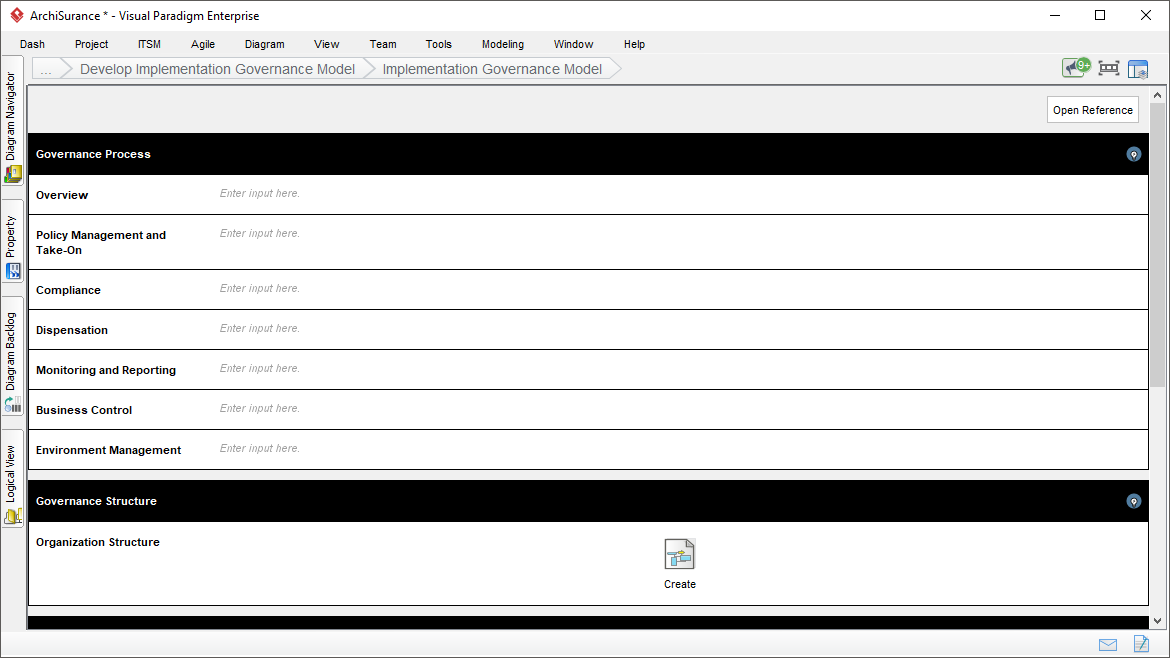Implementation Governance Model is one of the TOGAF deliverables you can create with the TOGAF tool.
Once an architecture has been defined, it is necessary to plan how the Transition Architecture that implements the architecture will be governed through implementation. Within organizations that have established architecture functions, there is likely to be a governance framework already in place, but specific processes, organizations, roles, responsibilities, and measures may need to be defined on a project-by-project basis.
The Implementation Governance Model ensures that a project transitioning into implementation also smoothly transitions into appropriate architecture governance.
Step 1: Develop Implementation Governance Model
Complete the form of ‘Implementation Governance Model’
Once an architecture has been defined, it is necessary to plan how the Transition Architecture that implements the architecture will be governed through implementation. In this activity you are required to document the Implementation Governance Model.
Governance processes are required to identify, manage, audit, and disseminate all information related to architecture management, contracts, and implementation. These governance processes will be used to ensure that all architecture artifacts and contracts, principles, and operational-level agreements are monitored on an ongoing basis with clear auditability of all decisions made.
Describe how various key governance processes will be performed. Here are the key governance processes:
- Policy Management and Take-On: All architecture amendments, contracts, and supporting information must come under governance through a formal process in order to register, validate, ratify, manage, and publish new or updated content. These processes will ensure the orderly integration with existing governance content such that all relevant parties, documents, contracts, and supporting information are managed and audited.
- Compliance: Compliance assessments against Service Level Agreements (SLAs), Operational Level Agreements (OLAs), standards, and regulatory requirements will be implemented on an ongoing basis to ensure stability, conformance, and performance monitoring. These assessments will be reviewed and either accepted or rejected depending on the criteria defined within the governance framework.
- Dispensation: A Compliance Assessment can be rejected where the subject area (design, operational, service level, or technology) are not compliant. In this case the subject area can be adjusted or realigned in order to meet the compliance requirements, or request a dispensation. Where a Compliance Assessment is rejected, an alternate route to meeting interim conformance is provided through dispensations. These are granted for a given time period and set of identified service and operational criteria that must be enforced during the lifespan of the dispensation. Dispensations are not granted indefinitely, but are used as a mechanism to ensure that service levels and operational levels are met while providing a level of flexibility in their implementation and timing. The time-bound nature of dispensations ensures that they are a major trigger in the compliance cycle.
- Monitoring and Reporting: Performance management is required to ensure that both the operational and service elements are managed against an agreed set of criteria. This will include monitoring against service and operational-level agreements, feedback for adjustment, and reporting.
- Business Control: The processes invoked to ensure compliance with the organization’s business policies.
- Environment Management: This identifies all the services required to ensure that the repository-based environment underpinning the governance framework is effective and efficient. This includes the physical and logical repository management, access, communication, training, and accreditation of all users.
